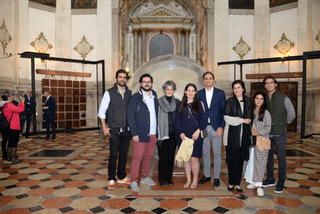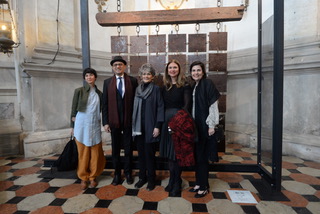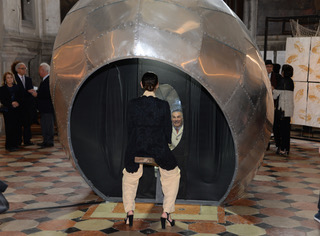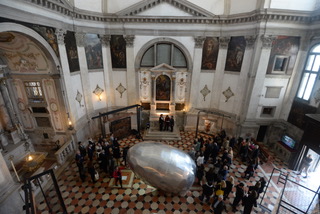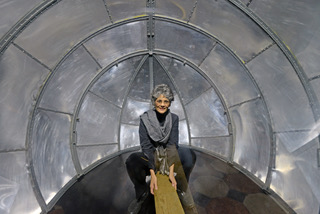Te Veo, Me Veo by Lidia León in Venice, Italy, 2019.
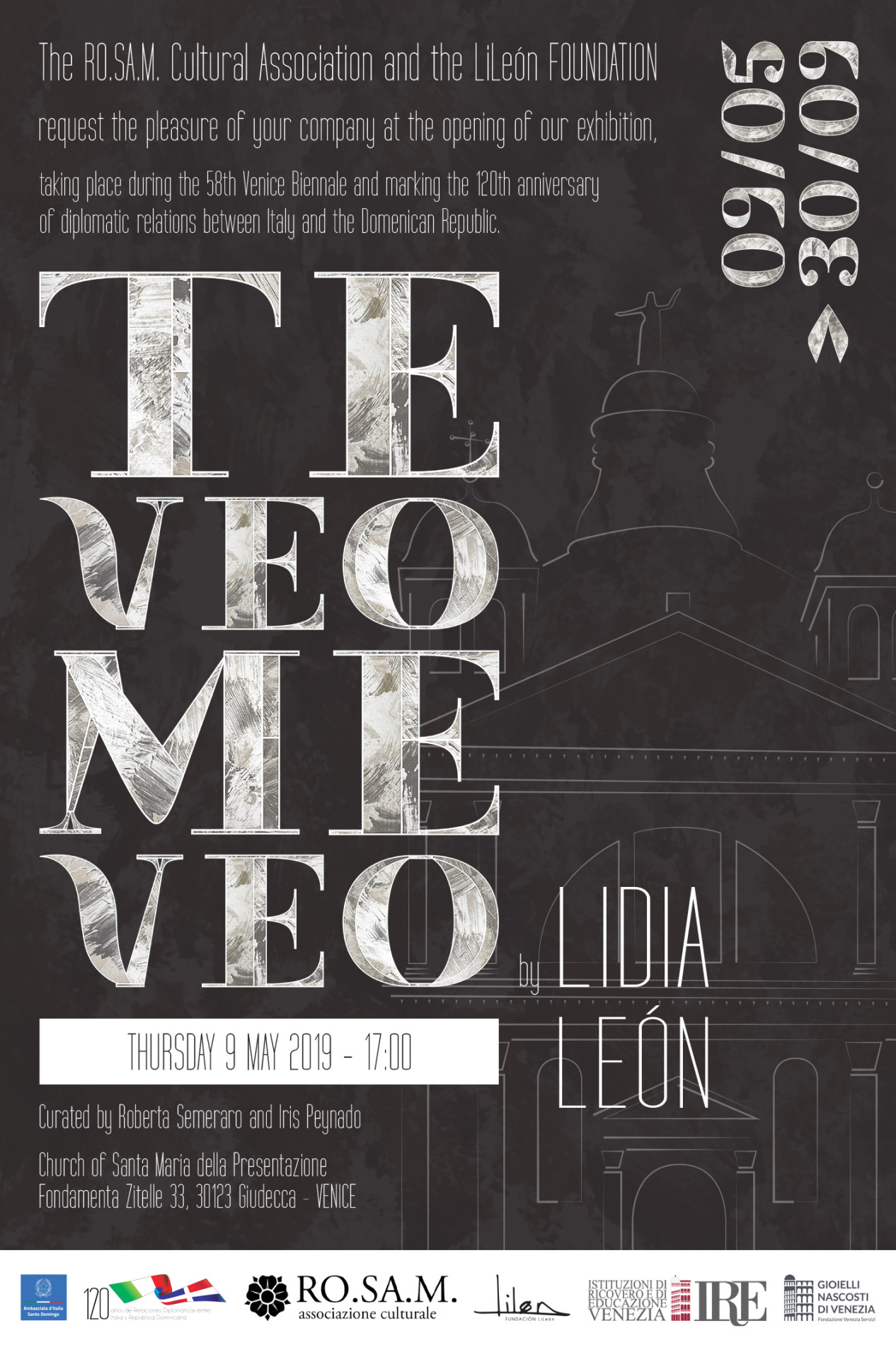
Lidia León TE VEO, ME VEO Curated by Roberta Semeraro and Iris Peynado Church of Santa María della Presentazione (delle Zitelle) Fondamenta Zitelle, Giudecca 33 – 30133 Venice 09.05 – 30.09.2019
PRESENTATION
“To discover the connection between science, nature and spirituality, revealing the link between the intangible and the visible.”
“My work is clear evidence that I am a reflection of a collective reality greater than my own self. We are drops from the same ocean; it stimulates me to see what is beyond.” Lidia León.
Venice, the international showcase for contemporary art, welcomes in its 58th edition of the Biennial of Art a new vibrant season enhanced with exhibitions presented in places that are attractions by themselves.
TE VEO, ME VEO (See You, See Me) is the title of the exhibition by Lidia León, an artist from the Dominican Republic that will be held at the Church of Santa Maria della Presentazione, better known as the Zitelle, with the curatorship of Roberta Semeraro and Iris Peynado.
Through her art, Lidia León reflects on issues of social and existential nature, such as intolerance and the lack of culture. Using her talent and creativity, she seeks to encourage integrated critical thinking in the new generations.
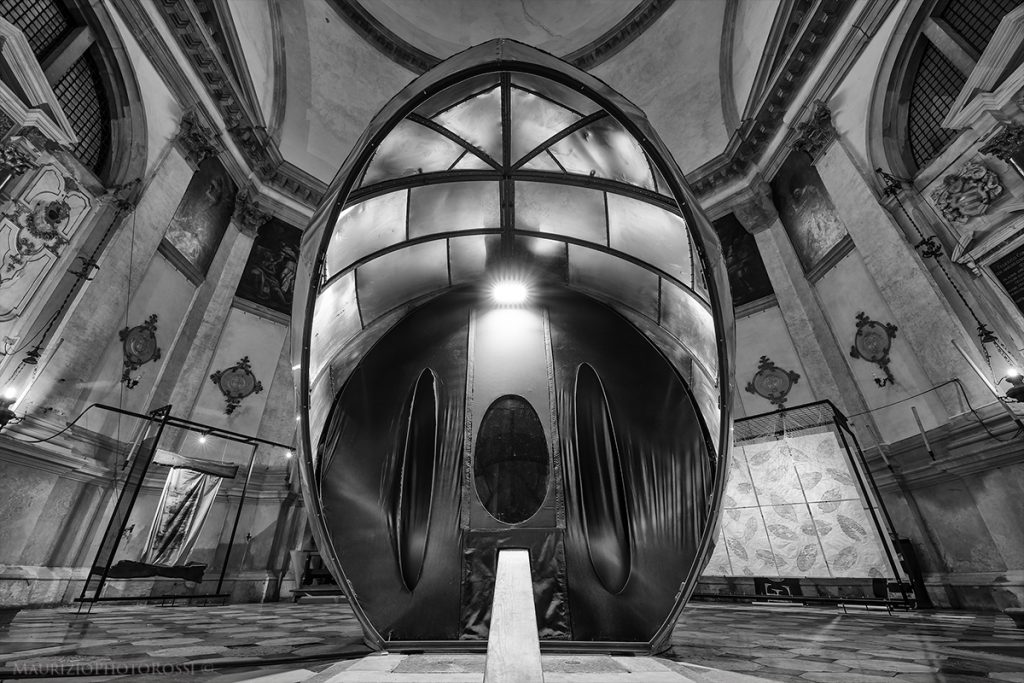
Titled “Te Veo, Me Veo,” the work of art is very interactive, an allegorical set of historical and philosophical references that invites the visitor to see oneself reflected in the work.
Along with “Te Veo, Me Veo“, the overall art exhibition includes the four works of the series “Wabi Sabi,” inspired by the Japanese art of finding beauty in impermanence and imperfection, of accepting the natural cycle of growth, a concept taken from the architect Tadao Ando and explored in Lidia León’s art work.
The series of works “Wabi Sabi” invites the viewer to look beyond, to accept and respect the natural processes of the transformation of matter in order to reach a complete awareness of ourselves and the ephemeral and fleeting substance we and the world are made of.
“Many of my proposals,” says Lidia León, “promote social inclusion through play, releasing tensions, stimulating the imagination. They are an invitation to the public to relate to my work, while promoting the social need of human beings for a space where our differences are respected, thus counteracting all types of discrimination.”
Because of these values that are behind the conceptual work of the artist, the Cultural Association RO.SA.M, active in backing sustainability projects related to culture in general and in particular to contemporary artistic languages, has welcomed with enthusiasm the invitation to organize Lidia León’s first exhibition in Europe. The exhibition also has the support of LiLeón FOUNDATION and sponsorship of the Italian Embassy in Santo Domingo on occasion of the 120th anniversary of the establishment of diplomatic relations between Italy and the Dominican Republic.
“I joined the Cultural Association RO.SA.M. to deepen my knowledge of Venice, the city that I fell deeply in love with, and because I had my country in my heart and was firmly convinced that, sooner or later, I would have the opportunity to propose a cultural project for the development and promotion of Dominican art,” says co-curator Iris Peynado. Last summer I focused my attention on the work of Lidia León, who had been invited to exhibit in Florence. This is how the idea of organizing an exhibition of her work in Venice for the Biennial came up, an idea that I proposed and, in particular, the curator Roberta Semeraro.”

“In the panoramas of the places where the artist has lived, I found the signs of that timeless beauty that is the most true and democratic because it is close to everyone that Lidia invites us to rediscover and appreciate”, says co-curator Roberta Semerano. “In fact, it seems that the Dominican artist feels an inescapable duty towards her society, when sharing her innate creative talent with the audience,” she explains.
STATEMENT BY ANDREA CANEPARI, AMBASSADOR OF ITALY IN THE DOMINICAN REPUBLIC
“Italy and the Dominican Republic have a long history based on culture. The first Dominican resident bishop, Alessandro Geraldini, was an important humanist, an Italian intellectual, friend of Christopher Columbus and the first builder of the Cathedral of Santo Domingo. Like him, many other Italians have contributed to create the valuable cultural relations between our countries. Many Dominican architects have studied in Italy and brought back to the country ideas of beauty in construction. Not only art, but also the development of agriculture and the Dominican Navy itself were born out of contacts with the Italians. This fruitful dialogue is again renewed as evidenced by the important presence of the artist Lidia León in Venice on occasion of the 58th Contemporary Art Biennial. A prominent artist with great ideals and ethical content in her works, so to see her creations in Venice is an inspiration to create new bridges between our two countries. “
ANNEX 1. CURATORIAL TEXT BY ROBERTA SEMERARO
Starting from the Greek aphorism “Know yourself” and the thoughts of Immanuel Kant, in the critique of practical reason when he says: “Act in such a way that you treat humanity, whether in your own person or in the person of another, always at the same time as an end and never simply as a means,”Lidia León’s exhibition can be considered as a reflection on our contemporary society.
In the interactive installation “Te Veo, Me Veo” (See You, See Me), that gives title to the exhibition, with an allegorical set of historical and philosophical references (from the cosmic form of the egg), León invites the visitor to recognize oneself in others and to rediscover one’s identity-in-depth in the reflection in the mirror.
To recognize oneself in others, the artist highlights, is a fundamentally ethical behavior that adds a healthy and balanced vision of others, overcoming discrimination of any kind. In addition to recognizing oneself in others, it is important to seek and find beauty in the simplicity of things and in particular in the natural course of events, accepting the cyclical nature of the world.
It is not a coincidence that León, who was trained in architecture, mentions the thinking of the Japanese architect Tadao Ando (known especially in Venice for his successful restoration of Punta della Dogana, one of the emblematic places of the city) who explains that Wabi Sabi is the Japanese art of seeking beauty in the imperfection and depth of nature, accepting the natural cycle of growth, decay and death. It is simple, slow and orderly. Above all it is authenticity.”
The series “Wabi Sabi” began in 2016 and calls the attention of the viewer to look beyond and discover the beauty in each day we are part of.
To accept and respect the natural process of decay and transformation of matter is important to reach a complete awareness of ourselves and the ephemeral and fleeting substance we and the world are made of. With these works, the artist proposes an aesthetic vision based on three simple truths: nothing lasts, nothing is finished, nothing is perfect. “Wabi” identifies rustic simplicity, freshness or silence that can be applied to artificial or natural objects. It can also refer to the imperfections that make things truly unique. While “Sabi” is the beauty and serenity that accompanies the advancing of age, when things wear out and time becomes visible in the signs of aging. Both words express concepts of transcendence and great spirituality.
ANNEX 2. THE VENICE BIENNIAL 123 years of history at the forefront of the promotion of new artistic trends and in accordance with a unique and multidisciplinary model.
The history of the Biennial has distant roots and is considered one of the most famous and prestigious cultural institutions in the world. The origins go back to 1895 with the first International Art Exhibition that would extend throughout the entire 20th Century, always at the forefront in the investigation and dissemination of new contemporary artistic trends. In 1932, the Biennial gave birth to the Film Festival, the first film festival in the world, which together with that of Music (since 1930), that of the Theater (since 1934), that of Architecture (since 1980) and that of Dance (since 1999) make up the heterogeneous and peculiar cultural offer of the Biennial.
The Venice Biennial began in 1895. Since 2008, it has been presided over by Paolo Baratta, who was previously president from 1998 to 2001. The 58th International Art Exhibition, entitled “May You Live in Interesting Times”, will be held from 11 May to 24 November 2019 (pre-opening 8, 9, 10 May). The title is an expression of the English language that for a long time was erroneously attributed to an ancient Chinese curse, which evokes periods of uncertainty, crisis and chaos; precisely “interesting times,” like the ones we are experiencing. Ralph Rugoff, current director of the Hayward Gallery in London, is the curator of the 58th Biennial.
ANNEX 3. LOCATION, WONDERFUL SOURCE OF INSPIRATION Church of Santa María della Presentazione (Zitelle)
The Church of the Zitelle was built in the 16th Century based on a design by the renowned architect Andrea Palladio and, with its location on the island of Giudecca, enjoys one of the most beautiful and privileged views of Piazza San Marco. It is connected to the pious place of the Zitelle. Founded in the mid-1500s, the site was intended for the education of the poor but very beautiful young women whose beauty could have been a motive for their falling to prostitution. It is known by Italians as The Zitelle (plural of single). Its architecture, initially based on a circular votive temple, was subsequently transformed into an elongated space to incorporate the wings of the hospice into the church. What we can see today is a façade crowned by a large dome flanked by two small bell towers. The lower part of the façade opens into two small niches, while the opening of a large semi-circular window of thermal type is highlighted in the upper part.
The exhibition
It was designed with a circular pattern to retake the Palladio’s dome, in which the central exhibition (Te Veo, Me Veo) dialogues with the side display (Wabi Sabi) in a continuous play of references. The configuration will be perfectly integrated into the sacred space respecting its historical and architectural characteristics without even slightly affecting the church’s walls. The impression perceived by the visitor is that the artist, Lidia León, felt a strong sense of belonging to the space, so she chose and created the works site specific.
La Giudecca: To see Venice from the water is to understand its true beauty
Leaving behind the Church of the Zitelle one can enjoy a view of a unique and overwhelming beauty. The attentive spectator can feel the binding relationship between the city and its lagoon. We are exactly in front of the “Marciana area” and its architectural marvels, Palazzo Ducale first on the characteristic island of La Giudecca and on the central vertex of the so-called “Palladio Triangle.”
On the left, the Church of the Redeemer built by the Senate of the Republic of Venice as a temple dedicated to Christ the Redeemer in gratitude for the end of the plague epidemic that hit Venice in the summer of 1575. The anniversary of that event is still celebrated in July when the church is the final station of a solemn procession in which a bridge of boats links the Giudecca to Venice. On the eve, Venetians and visitors gather at long tables along the sidewalks of the canals where they admire the fireworks display, while tasting the typical dishes of the festival. On the right, divided by a small channel, we find the island of San Giorgio Maggiore, with the homonymous church, one of the main works of Andrea Palladio, although the building, begun in 1566, would be completed years after the death of the master. Behind us, the echoes of an event that leaves something new, contemporary, although in fact … ancient.
ANNEX 4. BIOGRAPHIES Lidia León Cabral – Artist www.lileon.net
She was born in Santo Domingo, Dominican Republic in 1962. She graduated in architecture from the Universidad Nacional Pedro Henríquez Ureña [UNPHU] in Santo Domingo. As an artist, she is best known for her installations. Some of the events where Lidia has presented her works are:
- 27a Bienal Nacional de Artes Visuales in Santo Domingo, R.D.
- Bienal de Dibujo de Santo Domingo, R.D.
- 28 Bienal Nacional de Artes Visuales de Santo Domingo, R.D.
- Photo Imagen 2014 in Santo Domingo, R.D.
- Miami Mix and Wynwood Warehouse Project in Miami, Florida
- Centro Cardiovascular CEDIMAT in Santo Domingo R.D.
- Centro Cultural Perelló in Baní, Barahona, R.D.
- Centro Cultural E. León Jimenes, Santiago, R.D.
- Instituto Superior de Estudios Educativos Pedro Poveda (ISESP) in Santo Domingo, R.D.
- Casa de Arte Sosúa en Sosúa, R.D.
- Museo Sacro de La Vega, en La Vega, R.D.
- Universidad Nacional Pedro Henríquez Ureña (UNPHU) in Santo Domingo, R.D.
- Quinta Dominica in Santo Domingo, R.D.
She continues to collaborate with the Centro León, the Fundación E. León Jimenes and other cultural institutions of the Dominican Republic. She continues to explore the Wabi Sabi philosophy with her work, the art of rediscovering authenticity first of all by closely observing the cycles of nature with wit, surprise and gratitude. The need to expand her horizons and share her work with other cultures, has lead Lidia to spend most of the year in Canada.
Roberta Semeraro– Curadora www.asa-art.com/ROSAM/
She is an art historian, narrator, curator and contemporary art critic. She graduated in literature magna cum laude, specializing in the history of contemporary art at the La Sapienza University in Rome. She founded the cultural association La Sesta Arte. In 2010 she founded the Venetian cultural association Palazzo Zenobio / RO.SA.M. of which she became president a few years later. From 1991 to the present, she has written texts for art catalogues and curated exhibitions for numerous artists in different exhibition spaces and her activities have been reviewed in newspapers and mass media.
Iris Margarita Peynado – Co-curadora
She was born in Santo Domingo, Dominican Republic. Since 1982, she began her professional career as an actress in Italy. In 2017, she was named best actress in the most prestigious prize in Dominican Show Business Awards, the “Soberano” and was recognized as the best comedy actress in the IRIS Dominicana Movie Awards. As of the 90s, she has been active as a promoter of cultural and social activities, contributing in a decisive way to the organization in Italy of important events for the promotion of art and culture of the Dominican Republic. Since 2016 she is vice president of the Venetian cultural association RO.SA.M. Venice, 22 March 2019.
